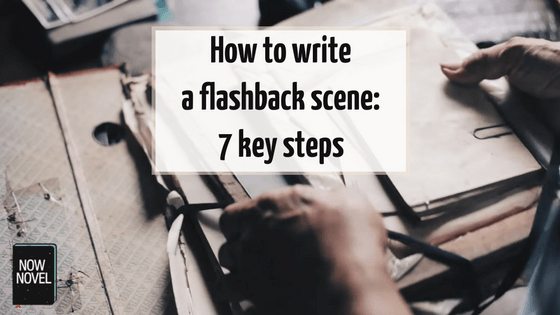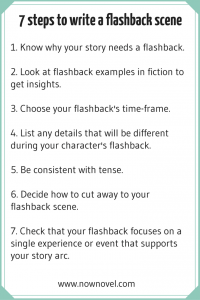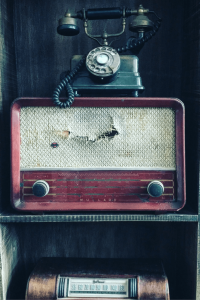Writing flashbacks is an important skill to master if your novel cuts across time periods or strongly features characters’ memories. Here are 7 key steps for how to write a flashback scene:
How to write flashbacks:
- Know why your story needs a flashback
- Look at flashback examples in fiction for insights
- Choose your flashback’s time-frame
- List details that will be different
- Practice how to write flashbacks with consistent tense
- Decide how you will transition to flashback scenes
To unpack each step a little:
1. Know why your story needs a flashback
In many novels, the events of the story take place chronologically, in straightforward succession from scene to scene. However, in stories involving characters’ memories or large leaps in time, flashbacks are useful for showing formative or crucial moments that drive characters’ present-time psychologies and decisions.
What is a flashback in literature?
Flashbacks are scenes inserted into the present narrative time-frame from a time period that precedes the primary story arc. A flashback example: A female narrator in her 50s describes the day her younger sibling drowned on a family vacation.
The example above strikes at something important about flashbacks: Flashbacks typically recall a scene of emotional power. They show the memories that haunt characters, although they can also be intensely happy moments.
Deciding whether or not your narrative needs a flashback
As an alternative to writing flashbacks, you can substitute exposition. Your central character can recall the day a traumatic or wonderful event happened. Yet describing the scene as though your character is living and experiencing it for the first time can be much more emotionally affecting. This allows the reader to see the pivotal story event with immediacy through your character’s eyes.
To decide whether an earlier event in your character’s backstory (e.g. witnessing a murder) needs a flashback scene, ask yourself:
- What are the benefits of showing the reader the earlier scene through my character’s eyes?
- Is the scene important enough to my central story arc to break from narrative continuity?
- How will I convey to the reader that this is a flashback and not an event happening in the present time of the story?
Provided your flashback contains important clues or explanations for your characters’ personalities and/or actions, it will not make your story less cohesive. Provided that readers understand your scene is a flashback (and not present-time narration), the flashback won’t create confusion.
2. Look at flashback examples in fiction to get insights
Writing flashbacks is storytelling time travel. Getting it right can be hard. So research novels that use this narrative device and see how other authors approach flashbacks.
An excellent example of a flashback is the opening of F. Scott Fitzgerald’s The Great Gatsby, where the narrator Nick Carraway recalls formative advice given him by his father:
‘In my younger and more vulnerable years my father gave me some advice that I’ve been turning over in my mind ever since.
“Whenever you feel like criticizing any one,” he told me, “just remember that all the people in this world haven’t had the advantages that you’ve had.”’
From the outset, this flashback creates the impression of a character who is observant and self-aware. It also establishes one of the central themes of The Great Gatsby: How people react to their privilege or disadvantages.
This example is just a snippet of flashback. There are longer examples, too. For example, in J.K. Rowling’s Harry Potter and the Goblet of Fire, there is a scene in which Harry uses a memory-storing magical device called a ‘pensieve’ to view a court hearing that took place many years before. The hearing is crucial to understanding present narrative events. Although the scene is not Harry’s own memory, it functions the same as a regular story flashback.

Get feedback on flashback scenes
Join Now Novel for constructive critiques from other members and pro crits when you upgrade.
START NOW3. Choose your flashback’s time-frame
When you write a flashback, it’s important to choose a reasonable time-frame for the scene. Typically, a flashback will consist of a single conversation or event that occurs over a single day. There’s nothing to say you can’t insert an entire week’s events in the middle of your story. Keeping the time frame of your flashback brief, however, will ensure the reader isn’t too distracted from the present arc of your story.
If you want to convey how an entire year in your character’s life was formative, for example, it is better to summarize this year in a few lines of expository narrative.
4. List any details that will be different during your character’s flashback
Times change. Because time isn’t static, remember to show how your characters and their circumstances are different during your flashback scene. For example, if a character living in 1999 recalls the 1960s, think about how slang, music and other cultural details differ.
A few small details (such as a song playing on the radio or a description of a period hairstyle) can signal that we’ve traveled back in narrative time. List the most significant differences between your character’s present life and their life during the time period of their flashback. Even if not all details make it into the story, it will help you strike an authentic note.
5. Learn how to write a flashback that has consistent tense
New authors especially struggle with tense. Your choices are multiple: you could write your flashback in the same tense as your present-time narrative, differentiating time periods with explicit reference to the year. For example:
‘It was November in 1960. The King’s ‘Are You Lonesome Tonight?’ was playing over the radio as we crowded around our mother’s kitchen.’
You could also write your flashback in a different tense to your main, present-time narrative. For example, if most of your novel is in recent past tense (‘The doorbell rang as I awoke’), you can switch to the present tense for your flashback scene:
‘It’s the 21st of November, 1960. The King’s ‘Are You Lonesome Tonight?’ is playing over the radio as we crowd around our mother’s kitchen.’
Whatever approach you choose, be consistent throughout your flashback scene. Pick a tense and stick with it.
6. Decide how you will transition to flashback scenes
Part of writing a successful flashback scene is knowing how and when to cut to the scene that lies outside of your story’s main chronology. Like all story scenes, your flashback scene should have good structure (NB: You can download our free, concise eBook guide to crafting effective scene structure here).
Some suggestions:
- Instead of writing a short intro paragraph to a flashback, launch straight into your flashback at the start of a scene or chapter. This way the transition is less obvious – you can signal a change in time simply in narration, as in the example using reference to the year in section 5 above.
- Try to insert flashback scenes after strong scenes in the present time of your story. This makes it easier for the reader to recall where the present-time narration left off once the flashback is over
7. Check that your flashback focuses on a single experience or event that supports your story arc
Once you’ve written your flashback scene, double-check that it is completely relevant to the later story. In a murder mystery novel, a flashback scene might provide an essential clue regarding the identity of the killer. In a character-driven family saga, it could show a formative familial relationship, conversation or confrontation that shapes your character’s outlook.
Make sure that your flashback scene draws your reader’s attention towards the key element that will deepen your reader’s understanding of key later scenes. This way, your story will feel cohesive even if the narrative does not follow a linear chronological path.
Do you want to improve your craft? Start getting helpful feedback on your flashbacks and other scenes from other writers.




12 replies on “How to write a flashback scene: 7 key steps”
I remember reading something by Samuel R. Delany (it might have been in _On Writing_). He gave good examples of when to start flashbacks and when not to. For example, if you start with a short setup to a scene and then immediately go to a flashback, you might as well just start with the previous scene.
A good pointer, Charles. Thanks for sharing!
In the movie “Bella” they had a flash forward, one of the few flash forwards in movies that I know of. It was a scene where the main character was imagining what would happen if she got an abortion, it worked quite well but it was also very ambiguous.
Interesting, Emily. I must look out for that movie. It can be quite ambiguous and confusing when the author jumps forward to some imagined place or time.
Wow! Amazing info. Thanks for sharing your knowledge, was really useful.
Thanks, Miguel! Happy you found this useful. Happy New Year!
[…] was not sure what a lot of it added. Perhaps that is why there was not much written as flashback, unlike Kaladin’s flashbacks in The Way of […]
Hey just wondering is this a good flashback. This is a flashback from a book I am making:
Darkstar kicks Shadow Storm back. Lillian runs and throws three Weapons at The Shadow Conqueror. The Shadow Conqueror blocks it. Shadow Storm and Darkstar clash swords. Shadow Storm is seen to be the better fighter. Shadow Storm kicks Darkstar back. Suddenly an explosion sends everyone back. Everyone looks up. It takes everyone including The Shadow Conqueror a moment to realize its Rodan’s greatest hero ever.
“Ash Stone?” Asked Shadow Storm. Shadow Storm suddenly has a flash back. It was when he was little. A figure is there. The same figure as now. “Mom? Who is that?” Asked Shadow Storm. His mom looks over. “I need to protect you!” Said the figure.
“Never!” Yelled his mother. His mother uses a Weapon and breaks the ceiling. The ceiling falls with a clash on the figure. The figure gets up. Suddenly Lily enters the room. She gets in front of them. Lily is younger and not as wise.
“Let me take you! She’s your enemy” said Lily. “Listen here. I can save you from Lily. I am part of Rodan! Lily is planning a war against the Rodan” said the figure. Lily suddenly turns to the figure. “Then I will kill your mother” said the figure.
There is a massive explosion from the figure and Lily runs to save them. Shadow Storms flashback ends. Shadow Storm looks horrified. The figure walks from out of the dust. Shadow Storm is in absolute shock.
“Oh great. Forgot about this” said The Shadow Conqueror to himself. Shadow Storm takes a few steps back in fear and confusion. Lillian looks around confused as well. She teleports off. “Ash Stone?” Asked Shadow Storm again. The figure is now seen as the dust, and everything clears. Shadow Storm looks in absolute fear. Everyone was silent.
No one wanted to speak. Not even The Shadow Conqueror. They just keep looking at each other. The silence that grows around them made them feel off and eerie. “WHO ARE YOU?” Asked Shadow Storm breaking the silence. “The figure from your flashback” said the voice.
Hi James, a few things could make this stronger:
This is just to start, but I would say the highest-level issue is confusing tense and erratic clarity/specificity. Keep going.
[…] Writing flashbacks is a tricky thing, but this article has some good tips and tricks for doing it correctly: https://www.nownovel.com/blog/incorporate-flashbacks-into-a-story/ […]
So what do you do if you’ve got a lot of scenes (like the better part of a novella) that need to be told, but happen to a character the reader doesn’t have a reason to care about until several books after they happened?
That’s a tough one, Wendy. Can you somehow move the action closer, so the character becomes more important earlier on?
If the readers don’t care upfront this could be really difficult. Can you tell me more?